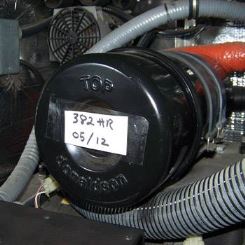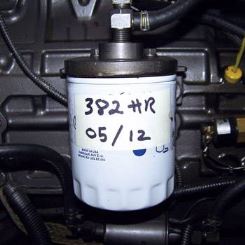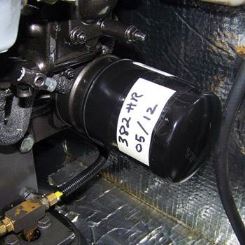Regular maintenance and exercise help to ensure that a motorhome’s onboard power plant stands at the ready when needed.
By Bill Hendrix, F761S
December 2012
Our motorhomes include a number of items that are important, and when we need them, we really need them. The auxiliary generator ranks at the top of that list, for several reasons. Under normal conditions, an onboard gen set provides reliable power when shore power isn’t available and battery power alone will not suffice. Not having an operating generator in these circumstances is inconvenient and may even shorten a trip. But you will discover how important it is to have a generator should you find yourself in the midst of a severe weather event. That’s when you will realize how much you need that mini power station in your motorhome.
So, it’s vital that your generator operates when it is called upon to provide electrical service to the motorhome. Therefore, regular maintenance and exercise are imperative. With a few exceptions, most generator maintenance closely parallels what is necessary for an automotive engine. Since generators come in a wide selection of sizes and styles, the type and frequency of maintenance will vary.
Two basic styles of engines are used to power the electrical generator (or alternator): diesel and gasoline. The gasoline engine may be modified to accept propane — either vapor or liquid — but this does not affect the importance of maintenance. The three basic electrical designs of the alternator are as follows:?1,800 rpm with a four-pole field/armature; 3,600 rpm with a two-pole field/armature; and variable speed with an electronically controlled output.
Many factors are examined when generator manufacturers formulate their maintenance schedules. Engine speed, wear factors, and experience are major considerations.
Scheduled Maintenance
There is no substitute for the owners manual when it comes to establishing a maintenance schedule. This book is your best source of information for the care and use of the equipment.
The very first maintenance occurs after the break-in period for the initial oil and oil filter change. Typically, the owners manual will suggest changing the oil and filter after the first 20 to 50 hours of operation. The engine will not be fully broken in, as the term might imply, but the initial wear particles need to be removed. You will be instructed to change the oil and filter on a regular schedule thereafter — typically after every 100 to 150 hours of operation or once every 12 months. Some diesel engines have a larger oil capacity and may have a longer run-time on the oil and filter — as much as 200 to 250 hours between changes — but manufacturers still recommend changing them at least once every 12 months. I like to write the date and generator hours right on the newly installed filter, in addition to keeping a written log for all maintenance.
 The air filter is just as important as the oil filter and should not be overlooked. A dirty air filter will restrict proper air intake and change the air-to-fuel ratio to a slightly richer mixture. This increases fuel consumption and reduces horsepower. There is also the danger that the increased negative pressure on the back side of the filter will put tiny holes in the filter material and pull dirty air into the cylinders, causing increased wear. A severely clogged air filter can prevent normal generator use entirely. Generators operated in dusty or dirty environments will require a filter change much sooner than the normal recommended time, just as your motorhome or car engine would. Usually, an annual change requirement is not given for the air filter, and the recommended schedule varies widely for different equipment, so rely upon the owners manual for the proper hourly maintenance interval.
The air filter is just as important as the oil filter and should not be overlooked. A dirty air filter will restrict proper air intake and change the air-to-fuel ratio to a slightly richer mixture. This increases fuel consumption and reduces horsepower. There is also the danger that the increased negative pressure on the back side of the filter will put tiny holes in the filter material and pull dirty air into the cylinders, causing increased wear. A severely clogged air filter can prevent normal generator use entirely. Generators operated in dusty or dirty environments will require a filter change much sooner than the normal recommended time, just as your motorhome or car engine would. Usually, an annual change requirement is not given for the air filter, and the recommended schedule varies widely for different equipment, so rely upon the owners manual for the proper hourly maintenance interval.
 The fuel filter is the next item on the maintenance schedule. The usual recommendation is that it be replaced at 250 to 500 hours. Although most have no annual change requirement, I like to replace the fuel filter at every other oil change, even if the hours haven’t elapsed. The generator’s owners manual also will note whether injector service, valve adjustments, or any other service is necessary, and when it should be done.
The fuel filter is the next item on the maintenance schedule. The usual recommendation is that it be replaced at 250 to 500 hours. Although most have no annual change requirement, I like to replace the fuel filter at every other oil change, even if the hours haven’t elapsed. The generator’s owners manual also will note whether injector service, valve adjustments, or any other service is necessary, and when it should be done.
For a proper break-in of the engine, the owners manual provides recommendations for a load schedule to follow for the first few hours of use. This will avoid a very early full load operation that might cause overheating and premature wear. Normally you should not load the generator at more than 50 percent of its output capacity for the first few hours; refer to the manual for the specifics for your particular generator.
Footnotes are always included on the maintenance recommendations, cautioning you to use a more frequent schedule when operating in extreme temperatures or dusty environments. For personal safety, thoroughly inspect the exhaust system at every opportunity, and make sure you have a functioning carbon monoxide alarm inside the motorhome. Avoid sleeping with the generator running. Also, be sure to disable the auto-start feature (if applicable) before doing any maintenance, when refueling your motorhome, or when storing your motorhome in an enclosed building. Don’t start or stop the generator under a load and, conversely, don’t run it for long periods without a load.
Gasoline will deposit a varnish in the carburetor if the generator is left idle for a few weeks. This varnish will cause the engine to malfunction in a variety of ways, and it may be necessary to have the carburetor rebuilt to cure the problem. The good news is that it is easily prevented just by running the generator, under a 50 percent load, for two hours every 30 days. Adding a fuel stabilizer such as Sta-Bil or OnaFresh to the gasoline also will help prevent varnishing, but be sure to run the engine after adding the stabilizer so as to circulate it through the carburetor. Read the label to determine the proper amount of treatment. You should continue to run the engine every 30 days as the owners manual says, especially for longer out-of-service periods. Fuel-injected engines are not subject to the varnishing effect to the same degree as carbureted engines, but, again, follow the recommendations in the owners manual and exercise the generator when out of service as described.
Running the generator periodically also helps to keep the brushes/brush contact surface in the electrical part of the generator in good shape and drives moisture from the windings.
If your generator cranks but will not start, check to make sure there is enough fuel (gas or diesel) in the tank for the generator to operate. While the motorhome’s engine may operate and the fuel gauge may show that there is fuel in the tank, remember that the motorhome’s fuel system will cut off the fuel supply to the generator to keep a reserve available for the engine. This is done so that prolonged use of the generator will not drain the tank and leave the motorhome stranded with no fuel. Your owners manual should indicate where that cutoff point is for your fuel system.
When the weather is cool and the humidity is very high, the venturi effect of a carburetor may cause icing, which can lead to rough running, stalling, or the throttle sticking. If the generator is equipped with a summer/winter selector lever, place it in the winter position. This will preheat the intake air to prevent icing.
Manufacturer Recommendations
Always follow the manufacturer’s recommendations for the type and grade of oil, and for the oil, fuel, and air filters. A fuel requirement for gasoline, LP-gas, or diesel fuel also will be listed. The owners manual may include restrictions on the use of ethanol and methanol blends of gasoline and restrictions on the use of propane blended with butane. It definitely will list temperature restrictions on No. 2 diesel fuel. Read the manual and be aware of the problems that might occur when the generator manufacturer’s recommendations are ignored. Consider oil analysis if you are really serious about maintenance (see “Oil Analysis 101,” FMC, March 2005 issue, page 62).
Also in the manual will be a list of typical loads for various appliances. No generator has an unlimited capacity. Compare the rated capacity of the generator with the loads applied. Also be aware that for normally aspirated engines (no turbocharger or blower), the engine power degrades approximately 3.5 percent for each 1,000 feet of altitude. This means that in the mountains of Colorado, you could lose as much as one-third of the generator’s capacity just because of the reduction of atmospheric pressure.
The coolant in liquid-cooled engines must be tested for loss of protective additives on an annual or more frequent basis. Test strips are available for this purpose, or your service center can do the testing at your regular service interval. Coolant testing usually is not performed unless requested. In addition, coolant should be changed within the recommended interval as listed in your owners manual.
Please note that RV generator manufacturers do not recommend modifying your generator exhaust with aftermarket kits or self-made systems that redirect or otherwise affect the flow of a correctly installed exhaust system. Exhaust backpressure reduces power and increases heat.
If your generator does not have an hour meter, have one installed, as a proper generator maintenance schedule is formulated on run-time. Always rely upon the owners manual for maintenance change intervals, as the hourly intervals noted earlier are generalizations.
Take care of the gen set and it will take care of you, especially at that critical time when it is most needed.
Troubleshooting Tips
Fails to crank or cranks slowly
- Low battery
- Bad battery connections
- Trying to start under load
Cranks but will not start
- Fuel below minimum level
- Low oil level may prevent spark
- Issue with spark plugs or spark plug wires
Starts but emits black smoke
- Very dirty air filter
- Choke stuck
- Dirty or varnished carburetor
Runs but surges
- Needs carburetor adjustment
- Needs speed control (governor) adjustment
- Needs general tune-up
Avoiding Carbon Monoxide Poisoning
Carbon monoxide (CO) is an odorless, tasteless, and colorless gas that is produced by sources such as gasoline engines, diesel engines, and propane-fueled appliances. Avoiding exposure to this potentially fatal gas, known as the silent killer, is critical to RV users.
The symptoms of CO poisoning include headache, weakness, drowsiness, decreased tolerance to exercise, visual disturbances, heart palpitations, nausea, and vomiting. If repeated exposure to low levels of carbon monoxide are not recognized, these symptoms — often misdiagnosed as influenza — may be chronic or recurrent.
Acute exposures to high levels of CO can cause a rapid progression to severe poisoning, in which case the symptoms are not apparent to the victim. The signs of acute toxicity are rapid heart and respiratory rates, irregular heart rhythms, vomiting, disorientation, low blood pressure, convulsions, respiratory failure, coma, and death.
Here are 15 recommendations to reduce the risk of CO poisoning:
1. Use a carbon monoxide warning alarm. As is true of a smoke alarm, reliance on a CO alarm is acceptable only if the device is in good working order and is tested periodically as directed by the manufacturer. Alarms have a recommended replacement age, which can be obtained from the product literature or from the manufacturer. The devices wear out and may not function as well or at all. Plus, advances in technology continue to be made to improve reliability. Look for an alarm that meets Underwriters Laboratories (UL) standard 2034. Most manufacturers recommend replacing the unit after 10 years.
2. Inspect your motorhome’s chassis and generator exhaust systems regularly before each outing, and after bottoming out or any other incident that could cause damage.
3. Inspect the RV for openings in the floor or sidewalls. If you locate a hole, seal it with a silicone adhesive or have it repaired before using your generator again.
4. If applicable, have your built-in vacuum cleaner checked to make sure it does not exhaust below your motorhome. Have the system changed if it does.
5. Inspect windows, door seals, and weather strips to ensure that they are sealing properly.
6. Yellow flames in propane-burning appliances such as furnaces, stoves, ovens, and water heaters usually indicate a lack of oxygen. Determine the cause of this condition and correct it immediately.
7. Do not operate your generator if the exhaust system is damaged in any way or if an unusual noise is present.
8. Park your motorhome so that the exhaust may easily dissipate away from the vehicle. Do not park next to high grass or weeds, snowbanks, buildings, or other obstructions that might prevent exhaust gases from dissipating as they should.
9. Keep in mind that shifting winds may cause exhaust to blow away from the motorhome one moment and under the coach the next.
10. When stopping for a long period of time, be aware of other vehicles around you, such as tractor-trailers at rest stops that may have their engines and refrigerators running.
11. Do not sleep with the generator operating.
12. Leave at least one roof vent open anytime the generator is running, even during the winter.
13. If you do not feel well, do not be fooled into thinking that it is because you have been driving too long, you ate too much, or you are suffering from motion sickness. Shut off the generator and step outside for some fresh air just to be sure.

